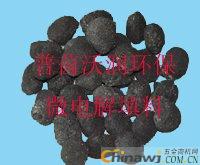**Static Experiment:**
The static experiment requires the following equipment: a 1-liter beaker, a small aeration device, micro-electrolytic filler, acid, alkali, and a coagulant. Begin by placing 1 kg of the filler into the beaker and positioning an aeration head at the bottom to create a simple aeration system. Next, fill the beaker with the wastewater to be tested, ensuring it doesn’t overflow. Turn on the aeration system and adjust the airflow to match the desired process conditions.
**Time Adjustment:** The test can be conducted in several time intervals, such as 30 minutes, 45 minutes, 60 minutes, or 90 minutes, depending on the required reaction duration.
**pH Adjustment:** Adjust the pH of the wastewater to values like 2, 3, 4, 5, and 6, then measure the pH of the effluent after each adjustment. This helps determine the optimal pH for the treatment process.
After the reaction is complete, pour out the wastewater and adjust the pH to between 8 and 9 using lime or liquid alkali. A small amount of coagulant, such as PAC (Polyaluminum Chloride), may also be added to promote flocculation and precipitation. Finally, collect the supernatant for further analysis.
**Dynamic Experiment:**
The dynamic experiment simulates the operation of a reactor on-site for continuous wastewater treatment. The reactor design can be customized based on the type of wastewater and site conditions. To calculate the performance, consider that the specific gravity of the filler is 1 ton per cubic meter, with a microporosity of 65%. If the micro-electrolysis process takes 60 minutes, one cubic meter of filler can treat 0.6 cubic meters of water per hour. For example, if the test runs for 30 minutes, the capacity becomes 60/30 × 0.6 = 1.2 cubic meters per hour. Similar calculations apply for other durations.
**"Iron-Carbon Filler" Experiment – Summary of Wastewater Treatment Technologies!**
1. **Printing and Dyeing Wastewater:** The micro-current and magnetic field effects between iron and carbon can break down chromophores, effectively decolorizing the wastewater.
2. **Electroplating and PCB Wastewater:** The new ecological iron ions generated at the anode reduce heavy metal complexes, while the electrophoretic effect and iron hydroxide co-precipitation help remove heavy metals and COD.
3. **Nitrobenzene, Aniline, Coking, Petrochemical, and Rubber Auxiliary Wastewater:** A 1.2V potential difference between iron and carbon creates a magnetic field that disrupts the molecular structure of pollutants, breaking carbon chains and rings, thus reducing COD and improving biodegradability.
4. **Pharmaceutical Wastewater:** The micro-current effect converts stable compounds into more degradable substances, reducing COD and eliminating pathogens in hospital wastewater.
5. **Papermaking Wastewater:** Micro-electrolysis, magnetic fields, and redox reactions convert long-chain polysaccharides into simpler sugars, enhancing biodegradability and enabling full removal through Fenton’s reagent.
6. **Livestock and High-Concentration Organic Wastewater:** Micro-electrolysis breaks down organic chains and destroys color-forming groups, reducing COD, ammonia nitrogen, and phosphorus levels.
**"Iron Micro-Electrolysis Filler" Experiment – Detailed Data for Various Wastewaters!**
1. **Pig Farm Wastewater:** Initial COD: 12,163.05 mg/L, Ammonia Nitrogen: 1,080.16 mg/L; After small-scale denitrification tower: COD: 1,790.43 mg/L, Ammonia Nitrogen: 13.28 mg/L; After micro-electrolysis: COD: 384.27 mg/L.
2. **Electroplating Wastewater:** Raw Water COD: 945 mg/L; After micro-electrolysis: COD: 135 mg/L.
3. **Nitrobenzene Wastewater:** Raw Water COD: 3,800 mg/L, Nitrobenzene: 82.5 mg/L; After Iron-Carbon Micro-Electrolysis + Fenton: COD: 107 mg/L, Nitrobenzene: 0.26 mg/L.
4. **Aniline Wastewater:** Raw Water COD: 5,035 mg/L; After Two-Stage Micro-Electrolysis + Fenton: COD: 113 mg/L.
5. **Modified Starch Wastewater:** Raw Water COD: 12,000 mg/L; After Two-Stage Micro-Electrolysis: COD: 5,875 mg/L.
6. **Cattle Wastewater:** Raw Water COD: 11,034 mg/L; After Two-Stage Micro-Electrolysis: COD: 1,416 mg/L; After Two-Stage Micro-Electrolysis + Fenton: COD: 857 mg/L.
7. **Chemical Wastewater:** Raw Water COD: 20,000 mg/L; After Two-Stage Micro-Electrolysis + Fenton: COD: 1,600 mg/L.

Off-Grid Solar System,Solar Energy System,Solar Solution Off-Grid
China Searun Solar Solution Co., Ltd. , https://www.srsolarlights.com